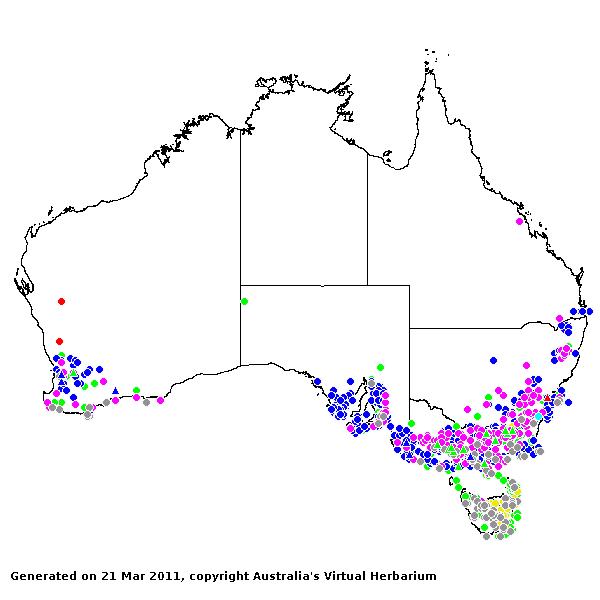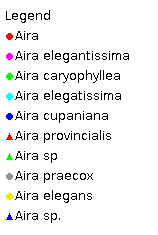Aira* L.,. Sp. Pl. 1: 66 (1753).
Derivation:.
Greek, a hammer, derivation uncertain.
Key references
(keys and floras):. G.Bentham, Flora Australiensis 7: 584–585
(1878); C.A.Gardner, Flora of Western Australia 1 Gramineae 37–39
(1952); J.C.Tothill and J.B.Hacker, Grasses of Southern Queensland 86–87
(1983); J.P.Jessop, Flora of South Australia 4: 1905–1906 (1986);
B.K.Simon, Key to Australian Grasses 63(1993); S.W.L.Jacobs and
S.M.Hastings, Flora of New South Wales 4: 594–595 (1993); N.G.Walsh, Flora
of Victoria 2: 459–461 (1994); D.I.Morris, Student's Flora of
Tasmania 4B: 245–247(1994); E.Edgar and H.E.Connor, Flora of New Zealand
5: 293–297 (2000); D.Sharp and B.K.Simon, AusGrass (2002); J.P.Jessop, Grasses
of South Australia 186–190 (2006); S.W.L.Jacobs, R.D.B.Whalley &
D.J.B.Wheeler, Grasses of New South Wales, 4th Ed, 112–113 (2008);
A.Wilson (ed.), Flora of Australia 44A: Poaceae 2: 259–264
(2009).
W.D.Clayton & S.A.Renvoize, Genera Graminum (1986), genus (191).
Naturalised. 8 species from North and South temperate regions. 5 species in Australia, WA,
SA, Qld, NSW, Vic, and Tas. Also New Zealand.
Habit. Small slender annual, tufted. Leaf blades narrow. Ligule an unfringed membrane.
Inflorescence.
Inflorescence paniculate, an open panicle with branches ending in single
spikelets, open or contracted, espatheate.
Spikelets.
Spikelets laterally compressed, 2 flowered, with 2 or more fertile florets,
awned, solitary, pedicelled; with naked rachilla extension, or with rachilla
terminating in a floret. Fertile spikelets disarticulating above glumes.
Glumes. Glumes more or less equal, about equal to spikelet, long relative to adjacent lemmas,
pointed, awnless, keeled or non-keeled, similar (membranous, delicate). Lower
glume 1–3 nerved. Upper glume 1–3 nerved.
Florets.
Fertile florets 2. Lemmas decidedly firmer than glumes (becoming papery), not
becoming indurated, entire at apex or incised, muticous or awned, 5 nerved,
glabrous, 1 keeled to not keeled. Awns when present, 1, dorsal, geniculate,
much shorter than body of lemma to much longer than body of lemma. Palea
relatively long, tightly clasped by lemma, apically notched, 2 nerved. Callus
short, blunt. Lodicules 2. Stamens 3. Grain small, fusiform, longitudinally grooved, compressed dorsiventrally. Hilum short. Embryo small.
2n = 14
and 28, 2 and 4 ploid, commonly adventive.
Habitat.
Mesophytic to xerophytic. Sandy soils. Species of open habitats.
Classification.
Pooideae; Poeae.
Notes. Mainly in the Mediterranean region, but extending from Scandinavia to South Africa;
several species have become naturalised in other temperate regions of the world
(Clayton Flora of Tropical East Africa Gramineae 1: 84 (1970)).
Economic Attributes
(Lazarides, FoA) Aira spp.: Annual winter-growing weeds and
fodder grasses mostly native to Europe and the Mediterranean.
Types Species. A. caerulea L.
Biogeographic Element. Clifford & Simon 1981, Simon & Jacobs 1990: Naturalised.


